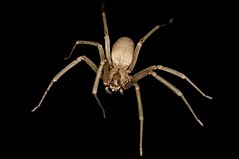Brown recluse spider
| Brown recluse | |
|---|---|
 |
|
| Scientific classification | |
| Kingdom: | Animalia |
| Phylum: | Arthropoda |
| Subphylum: | Chelicerata |
| Class: | Arachnida |
| Order: | Araneae |
| Infraorder: | Araneomorphae |
| Family: | Sicariidae |
| Genus: | Loxosceles |
| Species: | L. reclusa |
| Binomial name | |
|
Loxosceles reclusa Gertsch & Mulaik, 1940 |
|
 |
|
| Synonyms | |
|
|
The brown recluse, Loxosceles reclusa, Sicariidae (formerly placed in a family "Loxoscelidae") is a recluse spider with a necrotic venom and is one of two spiders (the other being the black widow) with medically significant venom in North America. Their bite, like various other recluse bites, sometimes requires medical attention.
Brown recluse spiders are usually between 6 and 20 millimetres (0.24 and 0.79 in), but may grow larger. While typically light to medium brown, they range in color from whitish to dark brown or blackish gray. The cephalothorax and abdomen are not necessarily the same color. These spiders usually have markings on the dorsal side of their cephalothorax, with a black line coming from it that looks like a violin with the neck of the violin pointing to the rear of the spider, resulting in the nicknames fiddleback spider, brown fiddler, or violin spider.
The violin pattern is not diagnostic, as other spiders can have similar markings (e.g. cellar spiders and pirate spiders). For definitive identification it is imperative to examine the eyes. While most spiders have eight eyes, recluse spiders have six eyes arranged in pairs (dyads) with one median pair and two lateral pairs. Only a few other spiders have three pairs of eyes arranged in this way (e.g., scytodids). Recluses have no obvious coloration patterns on the abdomen or legs, and the legs lack spines. The abdomen is covered with fine short hairs that, when viewed without magnification, give the appearance of soft fur. The leg joints may appear to be a slightly lighter color.
Adult brown recluse spiders often live about one to two years. Each female produces several egg sacs over a period of two to three months, from May to July, with approximately fifty eggs in each sac. The eggs hatch in about one month. The spiderlings take about one year to grow to adulthood. The brown recluse spider is resilient and can tolerate up to six months of extreme drought and scarcity or absence of food. On one occasion, a brown recluse survived in controlled captivity for over five seasons without any food at all.
...
Wikipedia
